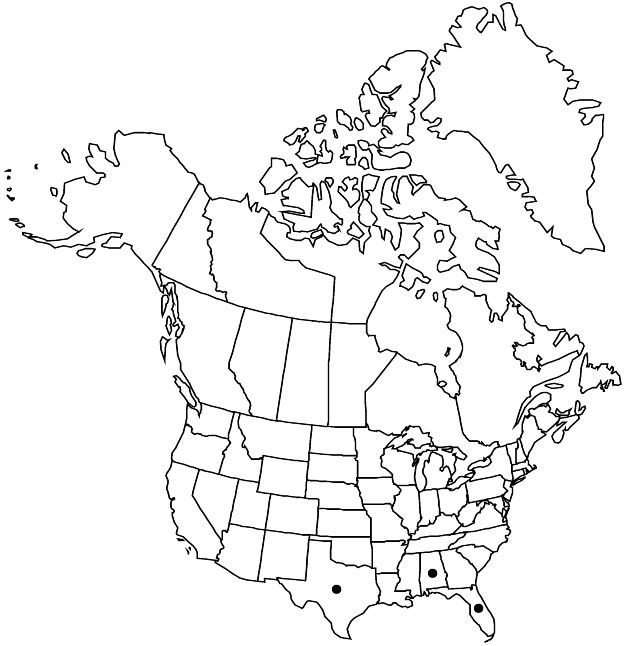Difference between revisions of "Sida cordifolia"
Sp. Pl. 2: 684. 1753.
FNA>Volume Importer |
imported>Volume Importer |
||
| Line 39: | Line 39: | ||
|elevation=0–300 m | |elevation=0–300 m | ||
|distribution=Ala.;Fla.;Tex.;Asia;introduced also in Mexico;West Indies;Central America;South America;Africa;Australia. | |distribution=Ala.;Fla.;Tex.;Asia;introduced also in Mexico;West Indies;Central America;South America;Africa;Australia. | ||
| + | |introduced=true | ||
|discussion=<p>A velvety-tomentose herb sometimes used in herbal medicines, <i>Sida cordifolia</i> is believed to have originated in India, but has been widely spread in warmer regions globally. In many areas it is considered to be an invasive weed. There is considerable variation in the flower color patterns; the velvety-tomentose indument and retrorsely barbed, relatively large or conspicuous spines can help in identification.</p> | |discussion=<p>A velvety-tomentose herb sometimes used in herbal medicines, <i>Sida cordifolia</i> is believed to have originated in India, but has been widely spread in warmer regions globally. In many areas it is considered to be an invasive weed. There is considerable variation in the flower color patterns; the velvety-tomentose indument and retrorsely barbed, relatively large or conspicuous spines can help in identification.</p> | ||
|tables= | |tables= | ||
| Line 63: | Line 64: | ||
|publication year=1753 | |publication year=1753 | ||
|special status=Introduced;Weedy | |special status=Introduced;Weedy | ||
| − | |source xml=https:// | + | |source xml=https://bibilujan@bitbucket.org/aafc-mbb/fna-data-curation.git/src/bb6b7e3a7de7d3b7888a1ad48c7fd8f5c722d8d6/coarse_grained_fna_xml/V6/V6_569.xml |
|subfamily=Malvaceae subfam. Malvoideae | |subfamily=Malvaceae subfam. Malvoideae | ||
|genus=Sida | |genus=Sida | ||
Revision as of 23:42, 27 May 2020
Subshrubs or shrubs, to 1.5 m. Stems erect, stellate-tomentose. Leaves: stipules free from petiole, 1-veined, linear, 5–8 mm, shorter than petiole; petiole 10–25 mm, to 1/2 length of blade, stellate-tomentose; blade broadly cordate to ovate-lanceolate, to 6 cm, reduced distally, 1–2 times longer than wide, base cordate, margins dentate to base, apex acute, surfaces softly velvety-tomentose. Inflorescences axillary, usually subsessile, crowded panicles or corymbs, sometimes solitary flowers. Pedicels 0.2–0.4 cm, enlarging slightly in fruit, shorter than calyx. Flowers: calyx prominently ribbed, 6–7 mm, densely stellate-tomentose, lobes ovate; petals yellow-orange, often with darker reddish base, 8–11 mm; staminal column hairy; style 8–14-branched. Schizocarps oblate-conic, 6–7 mm diam., apically hairy; mericarps 8–14, 4–5 mm, dorsally smooth, apex spined, spines to 2 mm, retrorsely barbed (variably developed, rarely suppressed). 2n = 28.
Phenology: Flowering year-round.
Habitat: Disturbed sites, savannas, open shrublands, pinelands
Elevation: 0–300 m
Distribution

Introduced; Ala., Fla., Tex., Asia, introduced also in Mexico, West Indies, Central America, South America, Africa, Australia.
Discussion
A velvety-tomentose herb sometimes used in herbal medicines, Sida cordifolia is believed to have originated in India, but has been widely spread in warmer regions globally. In many areas it is considered to be an invasive weed. There is considerable variation in the flower color patterns; the velvety-tomentose indument and retrorsely barbed, relatively large or conspicuous spines can help in identification.
Selected References
None.